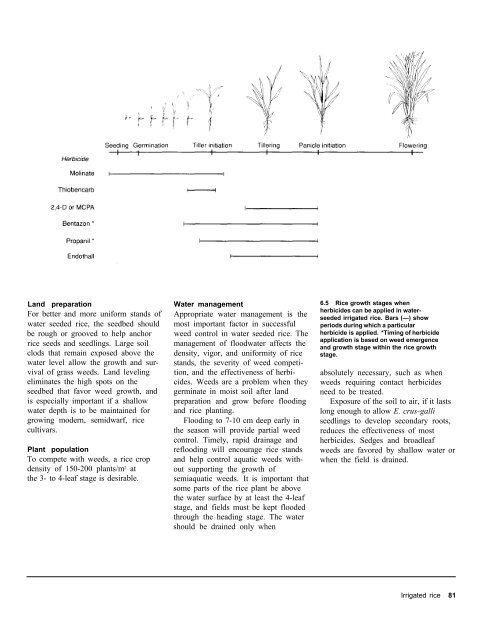A handbbok on Weed Control in Rice.pdf
A handbbok on Weed Control in Rice.pdf
A handbbok on Weed Control in Rice.pdf
You also want an ePaper? Increase the reach of your titles
YUMPU automatically turns print PDFs into web optimized ePapers that Google loves.
Land preparati<strong>on</strong><br />
For better and more uniform stands of<br />
water seeded rice, the seedbed should<br />
be rough or grooved to help anchor<br />
rice seeds and seedl<strong>in</strong>gs. Large soil<br />
clods that rema<strong>in</strong> exposed above the<br />
water level allow the growth and sur-<br />
vival of grass weeds. Land level<strong>in</strong>g<br />
elim<strong>in</strong>ates the high spots <strong>on</strong> the<br />
seedbed that favor weed growth, and<br />
is especially important if a shallow<br />
water depth is to be ma<strong>in</strong>ta<strong>in</strong>ed for<br />
grow<strong>in</strong>g modern, semidwarf, rice<br />
cultivars.<br />
Plant populati<strong>on</strong><br />
To compete with weeds, a rice crop<br />
density of 150-200 plants/m 2 at<br />
the 3- to 4-leaf stage is desirable.<br />
Water management<br />
Appropriate water management is the<br />
most important factor <strong>in</strong> successful<br />
weed c<strong>on</strong>trol <strong>in</strong> water seeded rice. The<br />
management of floodwater affects the<br />
density, vigor, and uniformity of rice<br />
stands, the severity of weed competi-<br />
ti<strong>on</strong>, and the effectiveness of herbi-<br />
cides. <strong>Weed</strong>s are a problem when they<br />
germ<strong>in</strong>ate <strong>in</strong> moist soil after land<br />
preparati<strong>on</strong> and grow before flood<strong>in</strong>g<br />
and rice plant<strong>in</strong>g.<br />
Flood<strong>in</strong>g to 7-10 cm deep early <strong>in</strong><br />
the seas<strong>on</strong> will provide partial weed<br />
c<strong>on</strong>trol. Timely, rapid dra<strong>in</strong>age and<br />
reflood<strong>in</strong>g will encourage rice stands<br />
and help c<strong>on</strong>trol aquatic weeds with-<br />
out support<strong>in</strong>g the growth of<br />
semiaquatic weeds. It is important that<br />
some parts of the rice plant be above<br />
the water surface by at least the 4-leaf<br />
stage, and fields must be kept flooded<br />
through the head<strong>in</strong>g stage. The water<br />
should be dra<strong>in</strong>ed <strong>on</strong>ly when<br />
6.5 <strong>Rice</strong> growth stages when<br />
herbicides can be applied <strong>in</strong> water-<br />
seeded irrigated rice. Bars (—) show<br />
periods dur<strong>in</strong>g which a particular<br />
herbicide is applied. *Tim<strong>in</strong>g of herbicide<br />
applicati<strong>on</strong> is based <strong>on</strong> weed emergence<br />
and growth stage with<strong>in</strong> the rice growth<br />
stage.<br />
absolutely necessary, such as when<br />
weeds requir<strong>in</strong>g c<strong>on</strong>tact herbicides<br />
need to be treated.<br />
Exposure of the soil to air, if it lasts<br />
l<strong>on</strong>g enough to allow E. crus-galli<br />
seedl<strong>in</strong>gs to develop sec<strong>on</strong>dary roots,<br />
reduces the effectiveness of most<br />
herbicides. Sedges and broadleaf<br />
weeds are favored by shallow water or<br />
when the field is dra<strong>in</strong>ed.<br />
Irrigated rice 81











